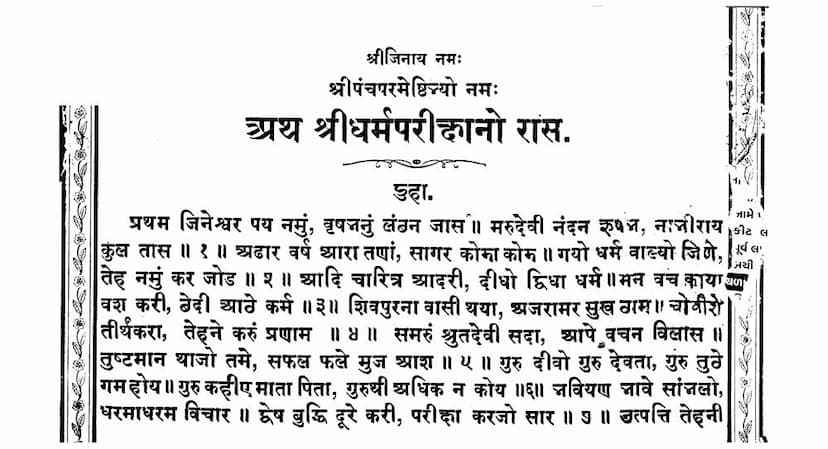Dharmpariksha Ras
Added to library: September 1, 2025

Summary
This Jain text, titled "Dharmpariksha Ras," is a Gujarati poetic work, likely a Ras or ballad, that aims to expound upon the principles of Jainism by contrasting them with various prevalent beliefs and practices, often highlighting their perceived flaws or inconsistencies. The text is attributed to an unknown author and publisher.
Here's a comprehensive summary based on the provided pages:
Overall Purpose:
The "Dharmpariksha Ras" (Essence of Religious Examination) appears to be a didactic work intended to guide readers towards the true path of Jainism by examining and critiquing other religious and philosophical viewpoints. It emphasizes the importance of critical thinking, discerning truth from falsehood, and adhering to the teachings of the Tirthankaras and enlightened beings.
Key Themes and Content:
-
Praise and Invocation: The text begins with invocations to Lord Jinendra (the liberated soul), the Panch Parmeshthis (the five supreme beings in Jainism), and the Goddess of Knowledge (Shrut Devi). It expresses a desire for the author's efforts to be fruitful.
-
The Role of the Guru: The text places immense importance on the Guru, referring to them as a divine being, parent, and exceeding all others in significance. The Guru is seen as the guide to understanding Dharma and Adharma.
-
Critical Examination (Dharmapariksha): A central theme is the call to examine Dharma and Adharma carefully, setting aside biases. The text implies that through examination, the true essence of Jain Dharma will become clear.
-
Cosmology and Geography: The initial sections describe the Jain cosmology, mentioning Jambudvipa, Mount Meru, various oceans, and islands. It details the division of land into Aryavarta (land of the Aryans, associated with true Dharma) and Anaryavarta (land of non-Aryans, often depicted as less righteous). Specific geographical locations and their characteristics are described, such as Mount Vaitadhya and the city of Vaijayantpur.
-
Illustrative Narratives (Stories): The bulk of the text appears to consist of stories or parables illustrating various points. These narratives often feature:
- Contrasting Ideologies: Stories contrasting Jain principles with those of other traditions (implied to be Brahmanical or other non-Jain paths).
- The Power of Knowledge and Reasoning: Characters who are learned and apply wisdom to understand truths.
- The Consequences of Wrong Beliefs: Narratives highlighting the negative outcomes of adhering to false doctrines or engaging in unrighteous actions.
- The Importance of Right Conduct: Stories showcasing the benefits of following Jain ethics, such as charity, chastity, and non-violence.
- The Role of Divine Beings and Avatars: While critiquing other traditions, the text does mention figures like Vishnu, Brahma, Shiva, and their avatars, but often within the context of questioning their actions or the myths surrounding them from a Jain perspective. The stories frequently use these figures to highlight perceived inconsistencies or moral shortcomings in other belief systems.
- The Journey of Individuals: Narratives often follow characters like Manoveg and Pawanveg, who engage in dialogues, travel, and learn about different paths, ultimately leading to an understanding of Jainism.
-
Critique of Rituals and Beliefs: The text seems to critique practices such as animal sacrifice (yajnas), idol worship of non-Jain deities, and the adherence to doctrines that contradict Jain principles. For example, the story of a Brahmin performing sacrifices involving violence is contrasted with the peaceful nature of Jain practices.
-
The Nature of Truth and Illusion: The text repeatedly calls for distinguishing truth from falsehood, emphasizing that mere appearances or popular beliefs do not equate to truth.
-
Literary Style: The text is written in a poetic meter common for Gujarati ballads (Ras), often using simple, accessible language interspersed with descriptions and dialogues. The "Dhal" (stanzas) and "Uda." (examples or illustrations) suggest a narrative structure common in such works.
Specific Story Examples (Based on pages provided):
- Manoveg and Pawanveg: These characters seem to be central to the narrative, traveling, conversing, and encountering different beliefs. Manoveg appears to be a proponent of Jain Dharma, while Pawanveg initially has different views.
- The Story of the Fish and the Cat: A story involving a fish sold by a fisherman that turns out to have unusual properties (cat's ears, blood) is used to question the truthfulness of certain claims or traditions.
- Critique of Hindu Deities: The text appears to question the actions and characteristics attributed to Hindu deities, suggesting they are not truly omniscient or morally perfect, contrasting them with the liberated beings of Jainism. This includes narratives that might touch upon the stories of Vishnu's avatars, Shiva's ascetic practices, or Brahma's creation myths.
- The Brahmin's Debate: A debate between Jain characters and Brahmins highlights the perceived superiority of Jain principles.
- The Tale of the Miserly King and the Wise Minister: A story illustrating the contrast between wrong economic or social policies and wise governance, possibly with a moral lesson related to detachment or right action.
- The Legend of Bali and Vishnu: The narrative touches upon the story of King Bali and Vishnu's Vamana avatar, likely to question the narrative from a Jain perspective, focusing on concepts of power, illusion, and true liberation.
- The Story of the Greedy King and the Scholar: This narrative might illustrate the consequences of greed and the importance of knowledge.
- The Tale of the Hypocritical Ascetic: A story likely critiques those who pretend to be spiritual but harbor inner desires or follow false practices.
Overall Message:
The "Dharmpariksha Ras" advocates for a life guided by reason, critical inquiry, and the adherence to the highest ethical and spiritual principles as embodied in Jainism. It encourages readers to look beyond superficial religious practices and delve into the core teachings of truth, non-violence, and detachment to achieve ultimate liberation. The extensive use of stories suggests a pedagogical approach to convey complex philosophical ideas in an engaging manner.